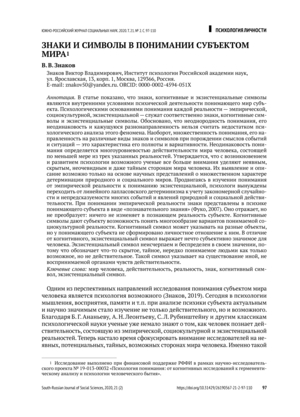Аннотация
В статье показано, что знаки, когнитивные и экзистенциальные символы являются внутренними условиями психической деятельности понимающего мир субъекта. Психологическими основаниями понимания каждой реальности — эмпирической, социокультурной, экзистенциальной — служат соответственно знаки, когнитивные символы и экзистенциальные символы. Обосновано, что неоднородность понимания, его неодинаковость и кажущуюся разнонаправленность нельзя считать недостатком психологического анализа этого феномена. Наоборот, множественность понимания, его направленность на различные виды знаков и символов при порождении смыслов событий и ситуаций — это характеристика его полноты и вариативности. Неодинаковость понимания определяется многоуровневостью действительности мира человека, состоящей по меньшей мере из трех указанных реальностей. Утверждается, что с возникновением и развитием психологии возможного ученые все больше внимания уделяют неявным, скрытым, неочевидным и даже тайным сторонам мира человека. Их выявление и описание возможно только на основе научных представлений о множественном характере детерминации природного и социального миров. Продвигаясь в изучении понимания от эмпирической реальности к пониманию экзистенциальной, психологи вынуждены переходить от линейного лапласовского детерминизма к учету закономерной случайности и непредсказуемости многих событий и явлений природной и социальной действительности. При понимании эмпирической реальности знаки представлены в психике понимающего субъекта в виде «познавательного знания» (Фуко, 2007). Оно отражает, но не преобразует: ничего не изменяет в познающем реальность субъекте. Когнитивные символы дают субъекту возможность понять многоообразие вариантов понимаемой социокультурной реальности. Когнитивный символ может указывать на разные объекты, но у понимающего субъекта не сформировано личностное отношение к ним. В отличие от когнитивного, экзистенциальный символ выражает нечто субъективно значимое для человека. Экзистенциальный символ неисчерпаем и беспределен в своем значении, потому что обозначает что-то скрытое, тайное, нередко понимаемое людьми как только возможное, но не действительное. Такой символ указывает на существование иной, не воспринимаемой органами чувств действительности.
Ключевые слова
Информация о финансировании
Исследование выполнено при финансовой поддержке РФФИ в рамках научно-исследовательского проекта № 19-013-00032 «Психология понимания: от когнитивных исследований к герменевтическому анализу и психологии человеческого бытия».
Библиографические ссылки
Веракса, А. Н. (2016). Символ и знак: диалектика символического познания. Вопросы философии, 1, 51–58.
Выготский, Л. С. (1984). Собрание сочинений: В 6‑ти т. Т. 6. М.: Педагогика.
Знаков, В. В. (2019). Понимание как психология возможного. Сибирский психологический журнал, 72, 6–20.
Иванов, В. И. (1994). Родное и вселенское. М.: Республика.
Кулагина, Н. В. (2006). Символ и символическое сознание. Культурно-историческая психология, 1, 3–10.
Леонтьев, А. А. (2001). Значение и смысл. Мир психологии, 2 (26), 13–20.
Леонтьев, А. Н. (1983). Некоторые проблемы психологии искусства. Избранные психологические произведения: В 2 т. М.: Педагогика.
Лобанова, Н. И. (2019). Вещь между знаком и символом (о семиотической деятельности вещи). Манускрипт, 10, 202–208.
Лосев, А. Ф. (2014). Проблема символа и реалистическое искусство. М.: Русскiй Mip.
Малевич, К. С. (2016). Мир как беспредметность. М.: Эксмо.
Никоненко, С. В. (2016). К вопросу о соотношении символа и знака. Вестник СПбГУ. Сер. 17. Философия. Конфликтология. Культурология. Религиоведение, 3, 47–53.
Осорина, М. В., Целяева, С. И. (2014). Использование информационных знаков для изучения процессов понимания социальных ситуаций. Вестник Санкт-Петербургского университета. Сер. 16. Психология. Педагогика, 1, 6–20.
Петросян, Ю. С. (2018). Символ: сущность и предназначение. Вестник Омского университета, 4, 103–114.
Рикер, П. (1995). Конфликт интерпретаций. Очерки о герменевтике. М.: Медиум.
Спирова, Э. М. (2011). Символ как понятие философской антропологии (Автореф. канд. дисс.). М.
Субботский, Е. В. (2007). Строящееся сознание. М.: Смысл.
Сухачев, В. Ю. (1997). История без субъекта. Метафизические исследования. В Выпуск 3. История. Альманах Лаборатории метафизических исследований при философском факультете Санкт-Петербургского государственного университета (28–42). СПб.: Алетейя.
Федоров, Н. А. (2012). Психологические потенциалы символа. Вестник Омского университета. Серия «Психология», 1, 24–30.
Фуко, М. (2007). Герменевтика субъекта: Курс лекций, прочитанных в Коллеж де Франс в 1981–82 учебном году. СПб.: Наука.
Царева, Н. А. (2017). Особенности герменевтического подхода к тексту в русском символизме. Libri Magistri, 3, 29–38.
Цыбуля, В. И. (2012). Функции символа в психотерапии. Консультативная психология и психотерапия, 2, 158–173.
Цыбуля, В. И. (2014). К проблеме психологического понимания и исследования символа в психотерапии. Культурно-историческая психология, 3, 114–122.
Шалина, О. С. (2010). Символическое опосредствование переживаний личности в критических ситуациях (Автореф. канд. дисс.). Москва.
Anderson, J. R. (2005). Human Symbol Manipulation Within an Integrated Cognitive Architecture. Cognitive Science, 29(2), 313–341.
Barsalou, L. W. (1999). Perceptual symbol systems. Behavioral and brain sciences, 4, 577–660.
Cantlon, J. F., Libertus, M. E., Pinel, P. et al. (2009). The Neural Development of an Abstract Concept of Number. Journal of Cognitive Neuroscience, 21(11), 2217–2229.
Chen, Q, Li, J. (2014). Association between Individual Differences in Non-Symbolic Number Acuity and Math Performance: A Meta-Analysis. Acta Psychologica, 148, 163–172.
Josephs, I. E. (1998). Constructing One's Self in the City of the Silent: Dialogue, Symbols, and the Role of 'As-If ' in Self-Development. Human Development, 41(3), 180–195.
Leibovich, T, Ansari, D. (2016). The Symbol-Grounding Problem in Numerical Cognition: A Review of Theory, Evidence, and Outstanding Questions. Canadian Journal of Experimental Psychology, 70(1), 12–23.
Reynvoet, B., Sasanguie, D. (2016). The Symbol Grounding Problem Revisited: A Thorough Evaluation of the ANS Mapping Account and the Proposal of an Alternative Account Based on Symbol–Symbol Associations. Frontiers in Psychology, 7. DOI: 10.3389/fpsyg.2016.01581


